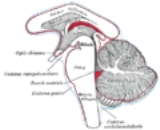
Cisterna magna
Encyclopedia
The cisterna magna is one of three principal openings in the subarachnoid space
between the arachnoid
and pia mater
layers of the meninges
surrounding the brain. The openings are collectively referred to as cistern
s. The cisterna magna is located between the cerebellum
and the dorsal surface of the medulla oblongata
. Cerebrospinal fluid
produced in the fourth ventricle
drains into the cisterna magna via the lateral apertures
and median aperture
.
The two other principal cisterns are the pontine cistern
located between the pons and the medulla, and the interpeduncular cistern
located between the cerebral peduncles.
Cerebral spinal fluid can also be obtained by puncture of the cisterna magna (cistern puncture).
Subarachnoid space
In the central nervous system, the subarachnoid cavity is the interval between the arachnoid membrane and pia mater....
between the arachnoid
Arachnoid mater
The arachnoid mater, literally from Latin "spider -like mother", is one of the three meninges, the membranes that cover the brain and spinal cord...
and pia mater
Pia mater
Pia mater often referred to as simply the pia, is the delicate innermost layer of the meninges, the membranes surrounding the brain and spinal cord. The word finds its roots in Latin, meaning literally "tender mother." The other two meningeal membranes are the dura mater and the arachnoid mater....
layers of the meninges
Meninges
The meninges is the system of membranes which envelopes the central nervous system. The meninges consist of three layers: the dura mater, the arachnoid mater, and the pia mater. The primary function of the meninges and of the cerebrospinal fluid is to protect the central nervous system.-Dura...
surrounding the brain. The openings are collectively referred to as cistern
Cistern (neuroanatomy)
In neuroanatomy, a cistern is any opening in the subarachnoid space of the brain created by a separation of the arachnoid and pia mater. These spaces are filled with cerebrospinal fluid...
s. The cisterna magna is located between the cerebellum
Cerebellum
The cerebellum is a region of the brain that plays an important role in motor control. It may also be involved in some cognitive functions such as attention and language, and in regulating fear and pleasure responses, but its movement-related functions are the most solidly established...
and the dorsal surface of the medulla oblongata
Medulla oblongata
The medulla oblongata is the lower half of the brainstem. In discussions of neurology and similar contexts where no ambiguity will result, it is often referred to as simply the medulla...
. Cerebrospinal fluid
Cerebrospinal fluid
Cerebrospinal fluid , Liquor cerebrospinalis, is a clear, colorless, bodily fluid, that occupies the subarachnoid space and the ventricular system around and inside the brain and spinal cord...
produced in the fourth ventricle
Fourth ventricle
The fourth ventricle is one of the four connected fluid-filled cavities within the human brain. These cavities, known collectively as the ventricular system, consist of the left and right lateral ventricles, the third ventricle, and the fourth ventricle...
drains into the cisterna magna via the lateral apertures
Lateral apertures
The lateral aperture is a paired structure in human anatomy. It is an opening in each lateral extremity of the lateral recess of the fourth ventricle of the human brain, which also has a single median aperture...
and median aperture
Median aperture
The median aperture drains CSF from the fourth ventricle into the cisterna magna. The two lateral apertures , one on the left and one on the right, are the primary routes for drainage of cerebrospinal fluid from the fourth ventricle into the cerebellopontine angle cistern...
.
The two other principal cisterns are the pontine cistern
Pontine cistern
The Pontine cistern is a considerable space on the ventral aspect of the pons.It contains the basilar artery, and is continuous behind with the subarachnoid cavity of the medulla spinalis, and with the cisterna cerebellomedullaris; and in front of the pons with the cisterna interpeduncularis....
located between the pons and the medulla, and the interpeduncular cistern
Interpeduncular cistern
The interpeduncular cistern is a wide cavity where the arachnoid extends across between the two temporal lobes....
located between the cerebral peduncles.
Cerebral spinal fluid can also be obtained by puncture of the cisterna magna (cistern puncture).

